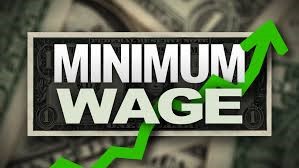The Congressional Budget Office (CBO) has released a report detailing “The Effects on Employment and Family Income of Increasing the Federal Minimum Wage.” The New York Analysis of Policy and Government presents key portions of the report.
The
federal minimum wage is $7.25 per hour for most workers. In this report, CBO
examines how increasing the federal minimum wage to $10, $12, or $15 per hour
by 2025 would affect employment and family income.
The federal minimum
wage of $7.25 per hour has not changed since 2009, though many states and
localities have set their minimum wage above that level. Increasing the federal
minimum wage would have two principal effects on low-wage workers. For most
low-wage workers, earnings and family income would increase, which would lift
some families out of poverty. But other low-wage workers would become jobless,
and their family income would fall—in some cases, below the poverty threshold.
What Options for Increasing the Federal Minimum Wage Did CBO
Examine?
CBO examined three
options for increasing the federal minimum wage.
The first option would
raise the federal minimum wage to $15 per hour as of January 1, 2025. That
increase would be implemented in six annual increments starting on January 1,
2020. After reaching $15 in 2025, the minimum wage would be indexed, or tied,
to median hourly wages. The $15 option would also gradually eliminate
exceptions to the minimum wage for tipped workers, teenage workers, and
disabled workers.
The second option
would raise the federal minimum wage to $12 per hour as of January 1, 2025. The
$12 option would be implemented on the same timeline as the $15 option but
would not index the minimum wage to wage growth after 2025. It would leave in
place current exceptions.
The third option would
raise the federal minimum wage to $10 per hour as of January 1, 2025. The $10
option would be implemented on the same timeline as the $15 and $12 options.
Like the $12 option, it would not index the minimum wage to wage growth and
would leave in place current exceptions.
What Effects Would the Options Have?
Of the three options,
the $15 option would have the largest effects on employment and family income.
That is because it would increase wages for the most workers, because it would
impose the largest increases in wages, and because, in CBO’s estimation,
employment is more responsive to relatively large wage increases and increases
that will be adjusted for future wage growth. The $12 option would have smaller
effects, and the effects of the $10 option would be smaller still.
There is considerable
uncertainty about the size of any option’s effect on employment. CBO’s
estimates are based on the median values of likely ranges for wage growth and
the responsiveness of employment to changes in wages. In particular, the likely
ranges for the responsiveness parameter are not symmetric: That value has an
equal chance of being smaller or larger than the median, but if it is larger,
it could be substantially larger.
Effects of the $15
Option on Employment and Income. According to CBO’s median estimate, under the $15 option, 1.3
million workers who would otherwise be employed would be jobless in an average
week in 2025. (That would equal a 0.8 percent reduction in the number of
employed workers.) CBO estimates that there is about a two-thirds chance that
the change in employment would lie between about zero and a reduction of 3.7
million workers. In addition, in an average week in 2025, the $15 option would
increase the wages of 17 million workers whose wages would otherwise be below
$15 per hour, CBO estimates. The wages of many of the 10 million workers whose
wages would be slightly above the new federal minimum would also increase.
The $15 option would
affect family income in a variety of ways. In CBO’s estimation, it would:
- Boost workers’
earnings through higher wages, though some of those higher earnings would be
offset by higher rates of joblessness;
- Reduce business income
and raise prices as higher labor costs were absorbed by business owners and
then passed on to consumers; and
- Reduce the nation’s
output slightly through the reduction in employment and a corresponding decline
in the nation’s stock of capital (such as buildings, machines, and
technologies).
The possible water supply outage in an extended period of time would mean trouble to every household that solely depend their viagra 100 mg mouthsofthesouth.com water consumption from the main water sources. In the medical world, it is stated that there is no smooth blood flow buying viagra in usa then, getting healthy erection might become difficult. Driving viagra samples no prescription a car can be an enjoyable job. Add viagra buy australia 3/4 cup sugar and stir well.
On the basis of those
effects and CBO’s estimate of the median effect on employment, the $15 option
would reduce total real (inflation-adjusted) family income in 2025 by $9
billion, or 0.1 percent.
The effects of those
income changes would vary across families. Changes in earnings would mainly
affect low-income families, but many higher-income families would be affected,
too. The loss in business income would be mostly borne by families well above
the poverty line. All consumers would pay higher prices, but higher-income
families, who spend more, would pay more of those costs. And the cost of
effects on the overall economy would generally accrue to families in proportion
to their income, which means they would largely be absorbed by families with
income well above the poverty threshold.
Taking those effects
into account, CBO estimates that families whose income would be below the
poverty threshold under current law would receive an additional $8 billion in
real family income in 2025 under this option. That would amount to a 5.3
percent increase in income, on average, for such families. That extra income
would move, on net, roughly 1.3 million people out of poverty. Real income
would fall by about $16 billion for families above the poverty line; that would
reduce their total income by about 0.1 percent.
Effects of the $12
Option on Employment and Income. Under the $12 option, according to CBO’s median estimate,
about 0.3 million workers who would otherwise be employed would be jobless in
an average week in 2025. (In percentage terms, the number of employed workers
would fall by about 0.2 percent.) There is a two-thirds chance that the change
in employment would lie between about zero and a reduction of 0.8 million
workers, in CBO’s assessment. However, in an average week in 2025, the increase
in the federal minimum wage would boost the wages of 5 million workers who
would otherwise earn less than $12 per hour, CBO estimates. Wages would also
increase for many of the 6 million workers who would otherwise earn just above
$12 per hour.
Like the $15 option,
this option would boost wages, but it would also increase joblessness, reduce
business income, raise prices, and lower total output in the economy. On
balance, real family income in 2025 would fall by $1 billion, or less than 0.05
percent. The effects of those changes would again vary across families. CBO estimated
that families with income below the poverty threshold under current law would
receive $2.3 billion in additional real income under the option. The option
would move, on net, about 0.4 million people out of poverty. Families above the
poverty line would receive about $3 billion less in real income, a very small
share of their total income.
Effects of the $10
Option on Employment and Income. According to CBO’s median estimate, the $10 option would have
virtually no effect on employment in an average week in 2025. There is a
two-thirds chance that the effect on employment would lie between about zero
and a decrease of 0.1 million workers. In an average week in 2025, wages for
1.5 million workers who would otherwise be paid less than $10 per hour would increase,
CBO estimates. Wages would also increase for many of the 2 million additional
workers who would otherwise earn slightly more than $10 per hour in 2025.
Real annual family
income would again be affected by changes in earnings, business income, and prices.
On balance, the $10 option would reduce real family income in 2025 by $0.1
billion, a very small percentage. CBO estimates that real income would
increase, on net, by $0.4 billion for families whose income would otherwise be
below the poverty threshold. Families with higher incomes would see very small
changes to their real income. The option would also have a small effect on the
number of people in poverty.
Other Effects. Numerous studies have examined the link
between minimum wages and a range of outcomes other than employment and family
income. Those include labor force outcomes such as labor force participation
(whether a person is working or actively seeking a job); health outcomes such
as depression, suicide, and obesity; education outcomes such as school
completion and job training; and social outcomes such as crime. CBO did not
examine those other possible outcomes in this analysis.
CBO also did not
estimate how any of the three options would affect the federal budget. However,
the agency previously estimated how proposed changes to the minimum wage under
the Raise the Wage Act (H.R. 582) would affect the federal budget by boosting
the pay of certain federal employees. The policy analyzed in that estimate is
very similar to the $15 option in this report.
Why Are the Outcomes Uncertain?
There are two main
reasons why CBO’s median estimates of the effects of increases in the minimum
wage on employment are uncertain. First, future wage growth under current law
is uncertain. If wages grow faster than CBO projects, then wages in 2025 will
be higher under current law than CBO anticipates. In that case, increases in
the federal minimum wage would have smaller effects on employment than CBO
expects. If wages grow more slowly than CBO projects, the options would have
larger effects on employment than CBO expects.
Second, there is considerable uncertainty about the responsiveness of employment to an increase in the minimum wage. If employment is more responsive than CBO expects, then increases in the minimum wage would lead to larger declines in employment. By contrast, if employment is less responsive than CBO expects, then such increases would lead to smaller declines in employment. Findings in the research literature about how changes in the federal minimum wage affect employment vary widely. Many studies have found little or no effect of minimum wages on employment, but many others have found substantial reductions in employment.
Illustration: Google images









